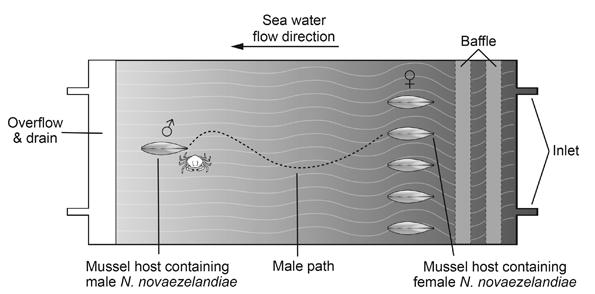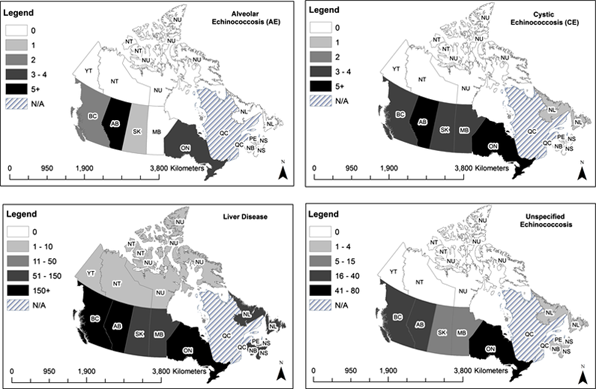News
Toxoplasmosis, the universal disease, now found also in Giant Panda
- Details
- Published on 28 October 2015
Toxoplasmosis, a disease caused by the protozoan Toxoplasma gondii, infects virtually all warm-blooded animals (mammals and birds), including humans. In February 2014, a 7-year-old female Giant Panda named Jin Yi died in Zhengzhou Zoo, China. Researchers from the Jilin Agricultural University in Changchun, the Military Veterinary Institute in Changchun and the China Conservation and Research Center for the Giant Panda, Ya’an, China have now published their analysis, based on immunological and molecular methods. They confirmed that Jin Yi died from acute gastroenteritis and respiratory symptoms caused by toxoplasmosis. This is the first report of toxoplasmosis in the Giant Panda. This finding is an additional example of the ubiquity of Toxoplasma gondii, a parasite famous for reports of its effects on the behaviour of infected mice.
Articles on Malaria and Plasmodium in Parasite
- Details
- Published on 22 April 2015
April 25th is World Malaria Day. People all around the world will take part in a wide range of activities to mark this day.
(http://www.worldmalariaday.org/)
On this occasion, Parasite would like to promote several articles on this topic that were published in the last three years.
New article “Detection of Toxoplasma gondii DNA in horse meat from supermarkets in France and performance evaluation of two serological tests".
- Details
- Published on 24 March 2015
This article takes a closer look at the horsemeat sold in French supermarkets.
The authors of this article, Abdelkrim Aroussi, Philippe Vignoles, François Dalmay, Laurence Wimel, Marie-Laure Dardé, Aurélien Mercier and Daniel Ajzenberg.
Abstract
“In France, some cases of severe toxoplasmosis have been linked to consumption of horse meat imported from the American continent where atypical strains of Toxoplasma gondii are more common than in Europe. Many seroprevalence studies are available in the literature but risk assessment of T. gondii infection related to horse meat consumption is not possible because of the absence of validated of serological tests and the unknown correlation between detection of antibodies against T. gondii and presence of tissue cysts.”
To be clear: to avoid any risk of toxoplasmosis, it’s recommended to cook horsemeat thoroughly.
A warning to those who like their meat rare.
Detection of Toxoplasma gondii DNA in horse meat from supermarkets in France and performance evaluation of two serological tests
Abdelkrim Aroussi et al.
DOI: http://dx.doi.org/10.1051/parasite/2015014
Nouvel article sur la "Détection de l’ADN de Toxoplasma gondii et évaluation des performances de deux tests sérologiques dans la viande de cheval vendue dans les supermarchés en France"
- Details
- Published on 23 March 2015
Et si on zoomait un peu sur ce qu’il y a dans nos assiettes, et plus particulièrement sur la viande de cheval vendue en supermarché ? Existe-t-il des risques à en consommer ?
Les auteurs de cet article (Abdelkrim Aroussi, Philippe Vignoles, François Dalmay, Laurence Wimel, Marie-Laure Dardé, Aurélien Mercier, Daniel Ajzenberg) se sont penchés sur la question.
Résumé
« En France, quelques cas de toxoplasmose sévère ont été liés à la consommation de viande de cheval qui avait été importée du continent américain où les souches atypiques de Toxoplasma gondii sont plus fréquentes qu’en Europe. De nombreuses études de séroprévalence existent dans la littérature mais l’estimation du risque d’infection par T. gondii après consommation de viande de cheval est impossible à cause de l’absence de validation des tests sérologiques et la corrélation inconnue entre la détection des anticorps anti T. gondii et la présence de kystes dans les tissus. »
En tout état de cause, pour éviter tout risque de toxoplasmose, il est recommandé de bien cuire notre viande. Annonce aux amateurs de viande bien saignante : le futur de la viande de cheval s’annonce moins rose !
Detection of Toxoplasma gondii DNA in horse meat from supermarkets in France and performance evaluation of two serological tests
Abdelkrim Aroussi et al.
DOI: http://dx.doi.org/10.1051/parasite/2015014
New article with videos “Mate locating and access behaviour of the parasitic pea crab, Nepinnotheres novaezelandiae, an important parasite of the mussel Perna canaliculus”
- Details
- Published on 17 March 2015
In their article, Oliver Trottier and Andrew G. Jeffs explain when, why and how the male pea crabs get into the mussel. When? At night. Why? Because they are searching for a female, of course! How? By gently stroking the mantle edge of the mussel, thus causing it to open.
This article is illustrated with 3 infrared videos, showing the different steps.
Abstract
“Pea crabs are globally ubiquitous symbionts in the marine environment that cause serious economic impact in the aquaculture production of several major bivalve species. However, little is known about their host-parasite interactions, especially the mating behaviour of these parasites that could prove useful for controlling their infestation in aquaculture. In this study, the mate location behaviour of male New Zealand pea crabs, Nepinnotheres novaezelandiae (Filhol, 1885), was observed when dwelling in its preferred host, the commercially important green-lipped mussel, Perna canaliculus.”
Discover this article and its 3 videos, and enter the world of 50 shades of green via the infrared videos…

Mate locating and access behaviour of the parasitic pea crab, Nepinnotheres novaezelandiae, an important parasite of the mussel Perna canaliculus
Oliver Trottier and Andrew G. Jeffs
DOI: http://dx.doi.org/10.1051/parasite/2015013
Meet Alessandro Massolo and Stefano Liccioli, authors in Parasite, on Canadian TV
- Details
- Published on 02 March 2015
Alessandro Massolo and Stefano Liccioli are the authors of the review "Echinococcus multilocularis in North America: the great unknown", which was published in the topical volume of Parasite "Innovation for the Management of Echinococcosis".
Over the last decade, studies have begun to shed light on the distribution and genetic characterization of Echinococcus multilocularis, the causative agent of alveolar echinococcosis (AE), in North America. In their review, they present the available data on E. multilocularis infections in wild and domestic animals and humans in North America and emphasize the lack of knowledge on the distribution of the parasite in wild and domestic hosts. Recent findings indicate that the parasite is likely expanding its range in the central region of the United States and Canada and that invasions of European strains might have occurred.

Their work has been featured on:
- CTVNews.ca
Alessandro Massolo and Stefano Liccioli interviewed as part of a report on Echinococcus multilocularis in coyotes and the possible risk to humans. - CBCNews Calgary
Information on coyote infection rates, human infection routes, and prevention strategies. - CTV Edmonton
Focus on transmission by pets and alveolar echinococcosis in humans.
Echinococcus multilocularis in North America: the great unknown
Alessandro Massolo, Stefano Liccioli, Christine Budke and Claudia Klein
DOI: http://dx.doi.org/10.1051/parasite/2014069
Parasite Now available on ePUB format! (February 2015)
- Details
- Published on 17 February 2015
EDP Sciences is pleased to announce the introduction of the ePUB digital format for all Parasite articles.
We have extended our existing suite of publication formats (PDF, HTML) to include ePUB, offering a range of formats to suit our readers varying needs.
ePUB is a format used for digital documents, it will allow scientific articles to be read on most of specialized eReaders and tablets.
The ePUB version will allow to download scientific texts and to read them very easily in an offline environment. ePUB adapts to suit different screen sizes, making for optimum text display and greater reading comfort.
New review article “An update on Acanthamoeba keratitis: diagnosis, pathogenesis and treatment”, by Jacob Lorenzo-Morales, Naveed A. Khan and Julia Walochnik (February 2015)
- Details
- Published on 17 February 2015
At the occasion of the ICOPA XIII congress, which was held in August 2014 in Mexico, selected authors were invited to publish papers in the Open Access peer-reviewed journal Parasite. A review on Acanthamoeba keratitis was chosen.
This high-quality 20-page review, with several original figures, deals with a worldwide increase in parasitic human infection. The three authors, Jacob Lorenzo-Morales (University of La Laguna, Tenerife, Spain), Naveed A. Khan (Aga Khan University, Karachi, Pakistan) and Julia Walochnik (Medical University of Vienna, Austria) present their current understanding on eye infections by amoebas, based on their long experience as leading scientists for this parasitic disease.
Free-living amoebae of the genus Acanthamoeba are causal agents of a severe sight-threatening infection of the cornea known as Acanthamoeba keratitis. The number of reported cases worldwide is increasing every year, mostly in contact lens wearers. Acanthamoeba keratitis has remained significant despite the advances in antimicrobial chemotherapy and supportive care. Altogether, this review may serve as the milestone for developing an effective solution for the prevention, control and treatment of Acanthamoeba infections.

Parasite being an open-access journal published under a Creative Commons licence (CC 4.0), the text and the figures can be freely re-used, provided that the source is correctly cited.
An update on Acanthamoeba keratitis: diagnosis, pathogenesis and treatment
Jacob Lorenzo-Morales, Naveed Ahmed Khan, Julia Walochnik
DOI: http://dx.doi.org/10.1051/parasite/2015010
Abstracts in four languages for new paper for the prevention of echinococcosis in remote communities (December 2014)
- Details
- Published on 28 November 2014
Proper disposal of carcasses and offal after home slaughter is difficult in poor and remote communities and therefore dogs readily have access to hydatid cysts containing offal from livestock, thus completing the parasite cycle of the tapeworm Echinococcus granulosus and putting communities at risk of cystic echinococcosis.
The new paper by Li et al. proposes a very simple way to eliminate this threat to public health: boiling livers and lungs for 30 minutes. This could be an efficient and cheap complement to other veterinary public health operations to control cystic echinococcosis.
This paper is part of the topical issue of Parasite “Innovation for the Management of Echinococcosis.” Invited editors: Dominique A. Vuitton, Laurence Millon, Bruno Gottstein and Patrick Giraudoux.
Because this paper contains information that could be useful not only to specialists, but also to physicians, veterinarians and the general public in countries infested with echinococcosis, including remote communities, the abstract of the paper is published in four languages: English, French, Chinese and Arabic. The paper is also illustrated by three full-page illustrations. Since the paper is fully open access and free to download, we expect it to be read by a wide audience in infested countries.
Boiling sheep liver or lung for 30 minutes is necessary and sufficient to kill Echinococcus granulosus protoscoleces in hydatid cysts
Parasite 2014, 21, 64
Celebrating 20 Years of Parasite (October 2014)
- Details
- Published on 14 October 2014
This year Parasite is celebrating its 20th anniversary. All issues of Parasite, published from 1994 up to now, are freely available on the journal’s website. Sponsored by the SFP (Société Française de Parasitologie), more than 1.220 articles can be downloaded on Parasite’s website at:
http://www.parasite-journal.org/component/issues/
All articles now have a DOI number, to identify content better and provide a persistent link to their location.
Parasite is an international open-access, peer-reviewed, online journal publishing high-quality papers on all aspects of human and animal parasitology. It is indexed in major databases, such as BIOSIS Previews, CAB International, Cambridge Scientific Abstract, Current Contents - Life Sciences, MEDLINE, PubMed, Science Citation Index, Science Citation Index Expanded and Zoological Record.
All papers published since 2011 are available not only from the publisher's website, but also from repositories such as PubMed Central and Europe PubMed Central, in various formats including PDF, ePub and PubReader.
This very modern and dynamic journal has managed to grow over the years. All published articles are available electronically. When subscribing to the email alert program, the subscriber will receive an email alert each time new articles are published online. Otherwise, the latest news, latest published articles and the most read articles, as well as tweets from the journal's Twitter account (@ParasiteJournal)

